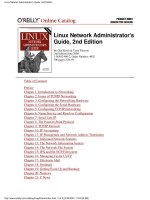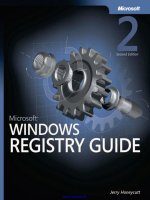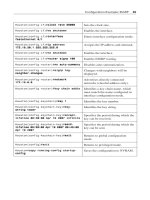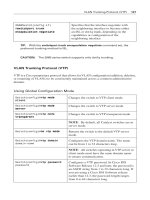Magento beginners guide, 2nd edition
Bạn đang xem bản rút gọn của tài liệu. Xem và tải ngay bản đầy đủ của tài liệu tại đây (26.84 MB, 320 trang )
www.it-ebooks.info
Magento Beginner's Guide
Second Edition
Learn how to create a fully featured, attractive online
store with the most powerful open source solution
for e-commerce.
Robbert Ravensbergen
Sander Schoneville
BIRMINGHAM - MUMBAI
www.it-ebooks.info
Magento Beginner's Guide
Second Edition
Copyright © 2013 Packt Publishing
All rights reserved. No part of this book may be reproduced, stored in a retrieval system,
or transmitted in any form or by any means, without the prior written permission of the
publisher, except in the case of brief quotations embedded in critical articles or reviews.
Every effort has been made in the preparation of this book to ensure the accuracy of the
information presented. However, the information contained in this book is sold without
warranty, either express or implied. Neither the authors, nor Packt Publishing, and its
dealers and distributors will be held liable for any damages caused or alleged to be caused
directly or indirectly by this book.
Packt Publishing has endeavored to provide trademark information about all of the
companies and products mentioned in this book by the appropriate use of capitals.
However, Packt Publishing cannot guarantee the accuracy of this information.
First published: March 2009
Second edition: June 2013
Production Reference: 1180613
Published by Packt Publishing Ltd.
Livery Place
35 Livery Street
Birmingham B3 2PB, UK.
ISBN 978-1-78216-270-4
www.packtpub.com
Cover Image by Asher Wishkerman ()
www.it-ebooks.info
Credits
Authors
Project Coordinator
Robbert Ravensbergen
Hardik Patel
Sander Schoneville
Proofreader
Reviewers
Christopher Smith
Eugene Ivashin
Karen Kilroy
Indexer
Monica Ajmera Mehta
Acquisition Editor
Andrew Duckworth
Graphics
Abhinash Sahu
Lead Technical Editor
Madhuja Chaudhari
Production Coordinator
Prachali Bhiwandkar
Technical Editors
Jalasha D'costa
Saumya Kunder
Cover Work
Prachali Bhiwandkar
www.it-ebooks.info
About the Authors
Robbert Ravensbergen is an open source and e-commerce expert from the Netherlands.
He started to work with open source solutions in the early days of Joomla!. He started his
own company, joomblocks.com, from which he has been serving clients with open source
solutions since 2009.
His first book about WordPress, Kickstart WordPress, Pearson Education, was released in the
Netherlands in 2010. After that, several open source related books on Joomla!, Magento,
and again WordPress followed. The second edition of Magento Beginner's Guide is his first
international book.
Sander Schoneville is a Technical Director at GroupDeal, a Dutch daily deals site based
on Magento. His has his background set in media psychology and business informatics. He
combines both fields to create effective websites.
He has worked with Magento since its early releases in 2008 and has written a Dutch book
about Magento.
Together with co-writer Robbert Ravensbergen, he's running an e-commerce blog at
.
www.it-ebooks.info
About the Reviewers
Eugene Ivashin was born in Russia and currently resides in Kiev, Ukraine.
He graduated from Dnepr State Academy of Building and Architecture in Dnepropetrovsk,
Ukraine and got a diploma with distinction as a Building Industry Automation Engineer
in 1997.
He has since worked at South Ukrainian Nuclear Power Plant as a repair engineer (six and
half years) and got interested in web development at that time. By the end of 2003, Eugene
left SU NPP, headed to Kiev and became a web programmer in a small private web design
agency where he spent more than 2 years building websites for various customers and
growing into a project manager in the process. At the same time, he continued freelancing
for separate customers and participating in a few sole proprietorship companies in the area
of web development and services. From April 2008, Eugene worked as a web developer and
a technical support at ExpoPromoter, a company leading in the tradeshow industry, providing
for a large catalog of tradeshow organizers across the world.
Finally, in January 2010, Eugene entered Varien Inc., which was later on rebranded as
Magento Inc., as a software engineer, but lately became a Technical Trainer. When Magento
was acquired by X.commerce, an eBay company, in August 2011, Eugene became a training
manager responsible for providing technical knowledge for all X.commerce employees.
Eugene speaks Russian, Ukrainian, and English. He likes to read science fiction books, admire
fine arts, and loves to draw pictures in particular by himself.
www.it-ebooks.info
Karen Kilroy is a freelance e-commerce web developer focused on the Magento Community
and Enterprise implementations and theming. Karen has worked as a frontend and backend
developer on a variety of Magento projects since early 2009. She is an enthusiastic instructor
and developer who enjoys experimenting with HTML5, CSS3, and responsive web designs. She
is also an instructor and course author for Magento U. Additionally, Karen is the sole inventor
of an e-commerce process called Shared Shopping (United States Patent Pending 13/350,321).
Prior to working with Magento, Karen worked with a wide variety of web and other
technologies during her more than 25 years' information technology career. In her spare
time, Karen volunteers as head coach of the Dragon Dream Team, an all-breast cancer
survivor dragon boat racing crew.
www.it-ebooks.info
www.PacktPub.com
Support files, eBooks, discount offers and more
You might want to visit www.PacktPub.com for support files and downloads related to
your book.
Did you know that Packt offers eBook versions of every book published, with PDF and ePub
files available? You can upgrade to the eBook version at www.PacktPub.com and as a print
book customer, you are entitled to a discount on the eBook copy. Get in touch with us at
for more details.
At www.PacktPub.com, you can also read a collection of free technical articles, sign up
for a range of free newsletters and receive exclusive discounts and offers on Packt books
and eBooks.
TM
Do you need instant solutions to your IT questions? PacktLib is Packt's online digital book
library. Here, you can access, read and search across Packt's entire library of books.
Why Subscribe?
Fully searchable across every book published by Packt
Copy and paste, print and bookmark content
On demand and accessible via web browser
Free Access for Packt account holders
If you have an account with Packt at www.PacktPub.com, you can use this to access PacktLib
today and view nine entirely free books. Simply use your login credentials for immediate access.
www.it-ebooks.info
www.it-ebooks.info
Table of Contents
Preface1
Chapter 1: Installation
13
Installing Magento locally
14
Requirements14
Time for action – installing Magento on a Windows machine
15
I'm on Mac; what should I do?
25
Installing Magento at a hosting service
28
How to choose a Magento hosting provider
28
Installatron29
Time for action – installing Magento using Installatron
29
What is SSL and do I need it?
35
Summary
36
Chapter 2: General Configuration
The installation is complete; what's next?
The Magento Dashboard
Managing Stores
General settings
Setting up taxes
General taxation settings
Product Tax Classes
Customer Tax Classes
Customer groups
Managing tax zones and rates
Managing tax rules
EU business to business VAT
Time for action – using VAT validation
Summary
www.it-ebooks.info
37
37
38
43
45
52
53
55
55
56
56
57
58
59
60
Table of Contents
Chapter 3: Categories and Attributes
61
What you need to know
An example category structure
Catalog defaults
Time for action – catalog settings
Working with attributes
Time for action – creating your own attribute
Using attribute sets
Time for action – creating your attribute set
Using categories
Time for action – creating your first category
Summary
Chapter 4: Simple Products
61
62
63
64
70
72
77
77
79
80
84
85
Adding a Simple Product
Step 1 – creating a product and assigning an attribute set
Step 2 – the General tab
Time for action – filling the General tab
Step 3 – the Prices tab
Time for action – filling the Prices tab
Step 4 – the Meta Information tab
Time for action – filling the Meta Information tab
Step 5 – the Images tab
Time for action – filling the Images tab
Step 6 – the Custom tab
Time for action – filling the Custom tab
Step 7 – the Inventory tab
Time for action – filling the Inventory tab
Step 8 – the Categories tab
Time for action – filling the Categories tab
Related products, up-selling, and cross-selling
Adding related products in Magento
Time for action – adding related products
Summary
Chapter 5: Beyond Adding Simple Products
Virtual products and Downloadable products
Adding a Virtual product
Time for action – adding a Downloadable product
Grouped products
Time for action – adding a Grouped product
Configurable products
[ ii ]
www.it-ebooks.info
85
86
86
87
91
91
92
92
93
94
97
98
98
99
101
101
103
105
106
107
109
110
110
112
122
123
128
Table of Contents
Time for action – creating a Configurable product
Simple products don't already exist
Simple products already exist
Bundle products
Time for action – creating a Bundle product
Summary
Chapter 6: Customer Relationships
129
132
133
136
138
143
145
Setting up guest checkout
Newsletters
Configuring contact options
Configuring customer options
Customer accounts on the frontend
Time for action – registering for an account
Customer accounts in the backend
Time for action – adding a customer
Managing an existing customer
145
146
152
155
156
156
159
160
163
Summary
167
Chapter 7: Accepting Payments
169
Common payment methods
Setting up Magento's default payment methods
Setting up PayPal Payments Standard
Time for action – starting to sell through PayPal
Setting up saved credit cards
Setting up checks / money orders
Setting up for a bank transfer
Setting up cash on delivery
Setting up purchase orders
Working with payment service providers
Selecting the right gateway
Setting up a payment service provider – an example
Time for action – installing and configuring a PSP extension
Summary
Chapter 8: Configuring Shipping
169
171
173
174
179
181
184
186
187
188
189
190
190
193
195
Logistics in Magento
Shipping processes and shipping arrangements
Default shipping methods in Magento
Configuring free shipping
Configuring Flat Rate shipping
Table Rate shipping
Time for action – configuring Table Rate shipping
[ iii ]
www.it-ebooks.info
195
196
196
197
198
200
201
Table of Contents
Other ways of calculating shipping costs
Presentation of shipping methods in your store
Magento's blind spots
Purchasing
Warehousing
Returns processing
Summary
Chapter 9: Customizing Your Store's Appearance
Magento themes
Your home page, CMS pages, and static blocks
Changing transactional e-mails
Time for action – changing the text inside transactional e-mails
Choosing between a pre-made and a custom-made theme
What to watch out for with premade themes
What to watch out for with custom-made themes
A combination
Suppliers for premade themes
Partners for Magento themes
Installing a theme
Making changes to your theme
Kinds of changes
Small changes
Medium changes
Big changes
205
205
206
207
207
208
208
209
209
210
216
218
221
222
223
223
224
224
225
227
227
227
228
228
Time for action – changing a heading to normal text
Time for action – changing the color of a heading
Time for action – removing a block from the right column
Summary
Chapter 10: Fulfilling Orders
229
235
238
243
245
Sales orders on the frontend
Time for action – creating a first sales order
Managing sales orders on the backend
Time for action – opening and processing an order
Some tips to handle your orders more efficiently
Creating sales orders on the backend
Time for action – creating a manual Sales Order
Returns and Credit Memos
Time for action – creating a Credit Memo
But what about my return process?
What if I need to handle these processes out of Magento?
Summary
[ iv ]
www.it-ebooks.info
245
246
252
255
261
261
262
265
266
268
268
269
Table of Contents
Chapter 11: Maintaining and Administrating Your Store
271
Managing your store
271
Overview of your Magento installation
272
Go-live checklist configuration settings
276
General settings
277
Web settings
277
HTML Head
278
Placeholder images
278
Contact information and e-mail addresses
279
Tax rates
279
Payment methods and shipping methods
279
Currency
280
Transactional e-mails – password text
280
Admin URL
280
404 (page not found)
281
Stock
281
Google Analytics
281
Caching
281
Index Management
281
Licenses
281
Daily tasks / cron jobs
281
Log cleaning
282
Database backups
282
Product meta information
282
Default images in columns
282
Escalations
283
Further development of your website
283
Time for action – planning for the future
284
Working with partners
286
A Magento theme
286
Functionality
288
Time for action – structuring development partnerships
288
General guidelines
290
Modifying Magento
290
Cache
290
Upgrading Magento
291
Summary291
Appendix: Pop Quiz Answers
Index
293
295
[v]
www.it-ebooks.info
www.it-ebooks.info
Preface
It was a few years ago, I think it was somewhere in 2008, when I first heard about Magento
as the new ''Top open source e-commerce solution''. Actually, at that moment it wasn't yet
that good, but I could see the potential of the software already. Especially thinking about
other open source solutions such as osCommerce at that time, or VirtueMart running on
Joomla. No, those were the days when the e-commerce market was still dominated by
large-scale companies and expensive solutions, but things have rapidly changed since then.
During 2009, the first edition of this book was published by Packt, written by William Rice.
And at that moment it was actually one of the very first books in the market giving readers
the opportunity to learn to work with Magento. Also in that area, times have changed and
various new versions of Magento have been released since then. So it's time for a completely
updated and rewritten version of that first, popular Magento book. And here it is.
Since 2009 we've been working on several Magento projects and learned to get to know
Magento the hard way, sometimes just by trying and failing every now and then. Everyone
already experienced with Magento will know what I'm talking about. But don't worry, this
book will give you a complete overview of what Magento is, how to install it, and how to
use it. When you create an online store with Magento, you usually follow a defined series
of steps. This book is arranged to support that process. Each chapter shows you how to get
the most out of every step.
By the time you finish reading this book you'll have a basic, but complete online store built
on Magento that is ready to start selling.
Robbert Ravensbergen
Sander Schoneville
www.it-ebooks.info
Preface
Introducing Magento
Magento is an ''open source'' software, which basically means that you are allowed to view,
edit, and contribute to the source code. A lot of people also think that ''open source'' means
''free''. Although it is certainly true that most open source solutions are available for free,
it isn't a mandatory part of the open source principle. Looking at Magento we immediately
recognize that, because Magento is available freely as well as in a paid for version. We'll
cover more on the differences between those versions later on.
As we already mentioned in this Preface, Magento isn't the only open source e-commerce
solution in the market. There are other ones as well. We'll name a few alternatives, without
being complete:
OpenCart
PrestaShop
osCommerce (more or less obsolete)
Joomla with VirtueMart
WordPress with e-commerce plugins like WooCommerce
Zen Cart
The first two candidates in this list are the more serious options, whereas the other ones
are generally used for smaller shops. But don't get me wrong, as I've already seen excellent
shops based on something relatively simple, such as WordPress with WooCommerce as well.
Looking at the commercial/paid market, there are really lots of players and it's hard to make
a choice if you're new to the business. Also in here, we'd like to name a few solutions, so that
you could get an idea of what's available in the market:
Shopify
X-Cart
Interspire
Volusion
Moreover, we see solution providers offering an online solution that you can use straight out
of the box, without having to do any installation. Magento is doing this as well and we'll tell
you more on this possibility in our Magento version overview.
[2]
www.it-ebooks.info
Preface
The history of Magento
It was way back in 2001 when Roy Rubin and Yoav Kutner founded a company named
Varien. They did many e-commerce implementations during those years, especially using
osCommerce. But they were never satisfied with the solution. The lack of stability and
flexibility made them think that it could be done better. So they decided to start a new
e-commerce project in 2007 and named it Magento. The very first beta version was
released in August of that year and it took them until March 2008 to release Magento
Version 1.0. From that moment on, things moved fast. The solution became incredibly
popular within a couple of years and new versions were released once or twice per
year. Starting from that first version in 2008, we've currently reached Version 1.7 at
the beginning of 2013.
Meanwhile, a lot has changed in the Varien company. It is now called Magento Inc. and
has been acquired completely by eBay during 2011. The Magento community is a bit
worried about the plans that eBay has with Magento, especially now that one of the
original founders, Yoav Kutner, has left the company. Even keeping possible scenarios
in mind, Magento has currently grown to be by far the most popular e-commerce
solutions available:
Especially knowing that older solutions such as osCommerce and VirtueMart are losing
market shares and Magento is still growing makes this picture even more clear about
the major role Magento is playing in the e-commerce market at this moment.
[3]
www.it-ebooks.info
Preface
Magento versions
Magento being the number one choice at this moment is great, but what does that mean for
the company delivering the solution? How are they making money to continue to support
the platform? This is where the various Magento versions come in. During the first few years
of Magento, only the free 'Community Edition' was available. Actually, this free Community
Edition is the one we'll be covering in this book since most users will start using that version.
Magento currently offers two other possibilities:
Enterprise Edition
The Enterprise Edition is Magento's flagship solution, made for large-scale online stores.
The Enterprise Edition has functionality on board that the Community Edition is missing
and we currently often see that new features are first released in this Enterprise Edition.
For companies using this version, the important fact is that Magento offers support on it.
The Enterprise Edition has its own version numbers that do not have anything to do with
the version number of the Community Edition. Magento Enterprise Edition is currently at
Version 1.12 and is currently priced at over $14,000 annually. If you'd like to read more on
the Enterprise Edition and its features please browse to:
/>
Formerly, Magento also offered a ''Professional Edition'', which was priced in between the
Community and Enterprise Editions. It was discontinued, forcing its customers to the more
expensive Enterprise Edition.
Magento Go
Seeing more and more competitors like, for instance, Shopify and Volusion offering online
e-commerce solutions, Magento has decided to offer such a service as well. Magento Go
is an online Magento platform, that you can simply rent by paying a monthly fee. The good
thing is that you do not have to worry about hosting, installation, and maintenance. Magento
will do it for you. The downside however, is that Magento Go isn't yet suitable for every
market and you cannot expand its functionality like you can in running your own installation.
If you are interested, please pay special attention to anything that is required for your local
market, payment service providers being the most important one. Pricing of Magento Go
currently starts at $15 per month for a single store in one language.
[4]
www.it-ebooks.info
Preface
More information on Magento Go can be found at:
.
Why choose Magento?
We've already mentioned that Magento is currently the most popular e-commerce solution,
but why would you choose Magento? There are plenty of alternatives, so what makes
Magento so popular? Since you're reading this book you have probably already made your
choice. Still it is good to look at a few pros and cons of Magento, to make sure that you made
the right decision for your business.
Magento pros
Multi site: One of the strongest pros of Magento is that it's relatively easy to set up
multiple stores in multiple languages offering different (or the same) products. You
are in control.
Product catalog management: Magento offers extended possibilities to set up
and manage your online product catalog. From simple products to complete sets
including options and customer variables anything seems to be possible. Magento
also supports selling digital (downloadable) products.
[5]
www.it-ebooks.info
Preface
Theming: If you want to change the look and feel of your store, you have to change
your Magento theme or install a completely different one. The number of themes
available is huge nowadays, and of course it is also possible to use a custom
design for your store. Generally speaking a good Magento theme isn't free. The
Marketplace Themeforest () is one of the possibilities
to search for and buy a standard Magento theme:
Extensions: Magento is already pretty complete out of the box. But there's always
room for improvement or maybe you need to change the functionality because of
local requirements. The Magento Community offers a lot of extensions that you can
install and use to change the behavior of your store. There are free as well as paid
for solutions available and there are (commercial) companies that completely focus
on delivering one or multiple Magento extensions.
Scalability: The Magento solution is not only versatile, it is very scalable as well.
You do not need a very large budget to start and once your company is growing,
Magento still offers you lots of possibilities. Magento can therefore be a very good
choice for small companies with high ambition levels.
Support: Although we already mentioned that official Magento support is available
for the Enterprise edition, you do not have to worry. There are lots of companies
throughout the whole world available to support you and help you achieve your goals.
These companies will not work for free, but it's good to know that there's a fallback if
you have to go further than this book and information available online have to offer.
[6]
www.it-ebooks.info
Preface
Magento cons
A book about Magento describing the downside of the software? Yes, we feel that it is
important to tell you the whole story. We are indeed Magento fans, but there are downsides
to every solution. And Magento has them as well. Let's take a quick look at them:
Magento is consumer oriented: Do you need to run a ''Business to business'' store?
Magento wasn't designed for that originally. Of course it is possible to use Magento
that way, but sometimes it doesn't fit so nicely. Recently we've noticed that
Magento is adding functionality to better support this customer group.
Magento is slow: Haven't you heard this one before? The code of Magento is very
well structured but therefore requires more resources than an average website.
More on this topic in the next chapter, but remember that if you want to run
Magento, you do not go for the cheapest hosting solution.
Magento is difficult: Well, it certainly isn't the easiest solution, because of the large
number of features and possibilities. But also if you need to do coding yourself, you
need a lot of knowledge about the product. This isn't a programmer's book though,
and we feel that learning Magento itself isn't too complicated. This book will help
you getting the job done.
What this book covers
Chapter 1, Installation, explains all you need to know to about setting up your own local
installation of Magento, or installing Magento at a hosting provider using Installatron.
Chapter 2, General Configuration, talks about Magento as a very versatile but complex
product. Before adding your products, you first need to take a closer look at setting up your
online store. In this chapter, you'll also learn to set up tax calculations.
Chapter 3, Categories and Attributes, explains that one of Magento's strengths is the way
it can handle almost every product type. In this chapter you'll learn to work with Product
Categories, Product Attributes, and Attribute Sets.
Chapter 4, Simple Products, talks about adding your first product in your store. During this
chapter, you'll learn how to properly set up your products and which fields are important to
pay attention to.
Chapter 5, Beyond Adding Simple Products, explains that now that you have added your first
product, it's time to explore the other possibilities Magento offers to set up your product
catalog. You'll learn to work with downloadable and configurable products.
Chapter 6, Customer Relationships, talks about looking at the other areas, starting with the
possibilities Magento offers for setting up and maintaining your customer databases.
[7]
www.it-ebooks.info
Preface
Chapter 7, Accepting Payments, explains that before being able to start selling, you'll need to
set up payment systems, so that you'll be able to receive a payment from your customer. In
this chapter we'll show you how to use Magento's common payment methods and how to
add your own using a Payment Service Provider.
Chapter 8, Configuring Shipping, will teach you to work with the built-in Shipping Methods of
Magento. We also included instructions to work with different kinds of shipping rates.
Chapter 9, Customizing Your Store's Appearance, explains what is often one of the first things
you would like to do: changing the look and feel of your online store. However, now that you
learned to work with Magento, it's the right time to work in this area and change the way
your online store will look.
Chapter 10, Fulfilling Orders. Everything is set up now to start receiving your first orders. But
once you do, how do you take control of the order process? In this chapter you will learn you
how to work with orders, shipping, invoices, and credit notes.
Chapter 11, Maintaining and Administrating Your Store, explains that once your store has
been set up you're not finished yet. Maintaining your online store is an ongoing process and
you have just started it. In this chapter you'll learn which areas you should pay attention to.
Besides that we added a checklist that you may use before bringing your store live.
What you need for this book
You do not need any specific software to be able to use the instructions in this book. Just
use a modern Windows computer or Mac. You'll need the following tools as well, but it's
completely up to you to choose the tool you like:
An FTP client, for instance, Filezilla.
Photo editing software for your images. Photoshop is often used, but expensive.
Actually any editing tool that you know how to use should be able to deliver good
results.
A text editor, such as Notepad++ (Windows) or Coda 2 (Mac).
Who this book is for
If you are a nontechnical person and are discouraged by the complexity of this powerful
e-commerce application, this book is ideal for you. This book would also suit someone with
e-commerce knowledge, but requires a guide to getting started with Magento.
Conventions
In this book, you will find several headings appearing frequently.
[8]
www.it-ebooks.info
Preface
To give clear instructions of how to complete a procedure or task, we use:
Time for action – heading
1.
2.
3.
Action 1
Action 2
Action 3
Instructions often need some extra explanation so that they make sense, so they are
followed with:
What just happened?
This heading explains the working of tasks or instructions that you have just completed.
You will also find some other learning aids in the book, including:
Pop quiz – heading
These are short multiple-choice questions intended to help you test your own understanding.
Have a go hero – heading
These practical challenges give you ideas for experimenting with what you have learned.
You will also find a number of styles of text that distinguish between different kinds of
information. Here are some examples of these styles, and an explanation of their meaning.
New terms and important words are shown in bold. Words that you see on the screen, in
menus or dialog boxes for example, appear in the text like this: "On the Select Destination
Location screen, click on Next to accept the default destination."
Warnings or important notes appear in a box like this.
Tips and tricks appear like this.
[9]
www.it-ebooks.info
Preface
Reader feedback
Feedback from our readers is always welcome. Let us know what you think about this
book—what you liked or may have disliked. Reader feedback is important for us to
develop titles that you really get the most out of.
To send us general feedback, simply send an e-mail to , and
mention the book title through the subject of your message.
If there is a topic that you have expertise in and you are interested in either writing or
contributing to a book, see our author guide on www.packtpub.com/authors.
Customer support
Now that you are the proud owner of a Packt book, we have a number of things to help
you to get the most from your purchase.
Downloading the example code
You can download the example code files for all Packt books you have purchased from your
account at . If you purchased this book elsewhere, you can
visit and register to have the files e-mailed directly
to you.
Errata
Although we have taken every care to ensure the accuracy of our content, mistakes do happen.
If you find a mistake in one of our books—maybe a mistake in the text or the code—we
would be grateful if you would report this to us. By doing so, you can save other readers from
frustration and help us improve subsequent versions of this book. If you find any errata, please
report them by visiting selecting your book,
clicking on the errata submission form link, and entering the details of your errata. Once your
errata are verified, your submission will be accepted and the errata will be uploaded to our
website, or added to any list of existing errata, under the Errata section of that title.
[ 10 ]
www.it-ebooks.info









